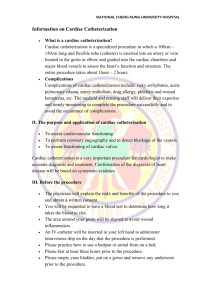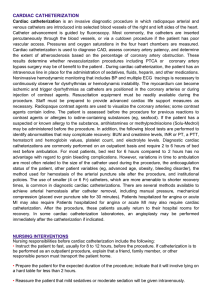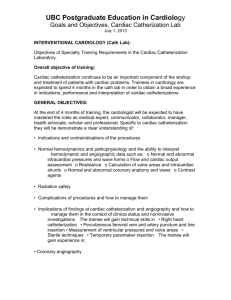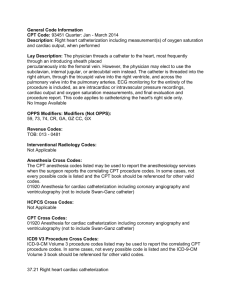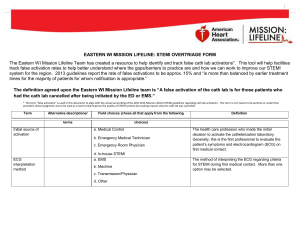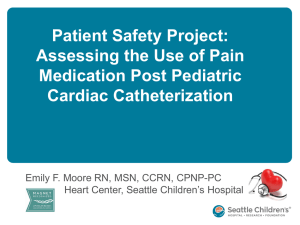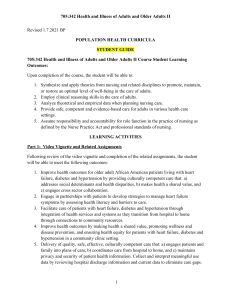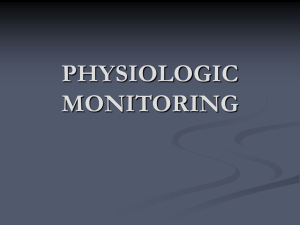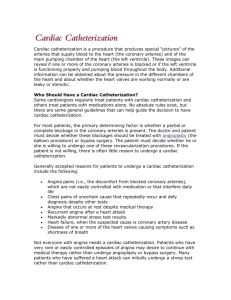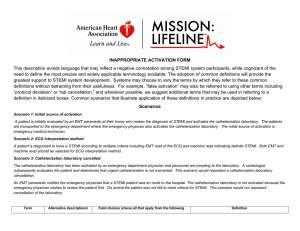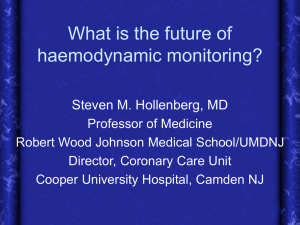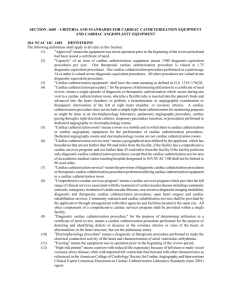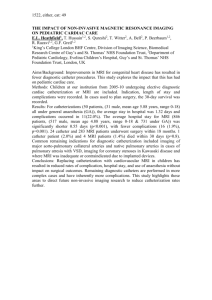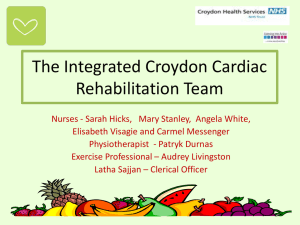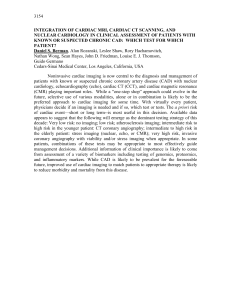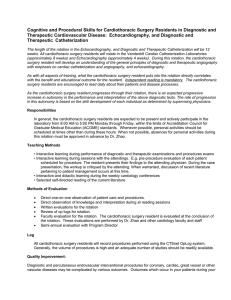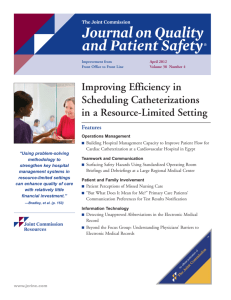PEDIATRIC CARDIOLOGY
advertisement
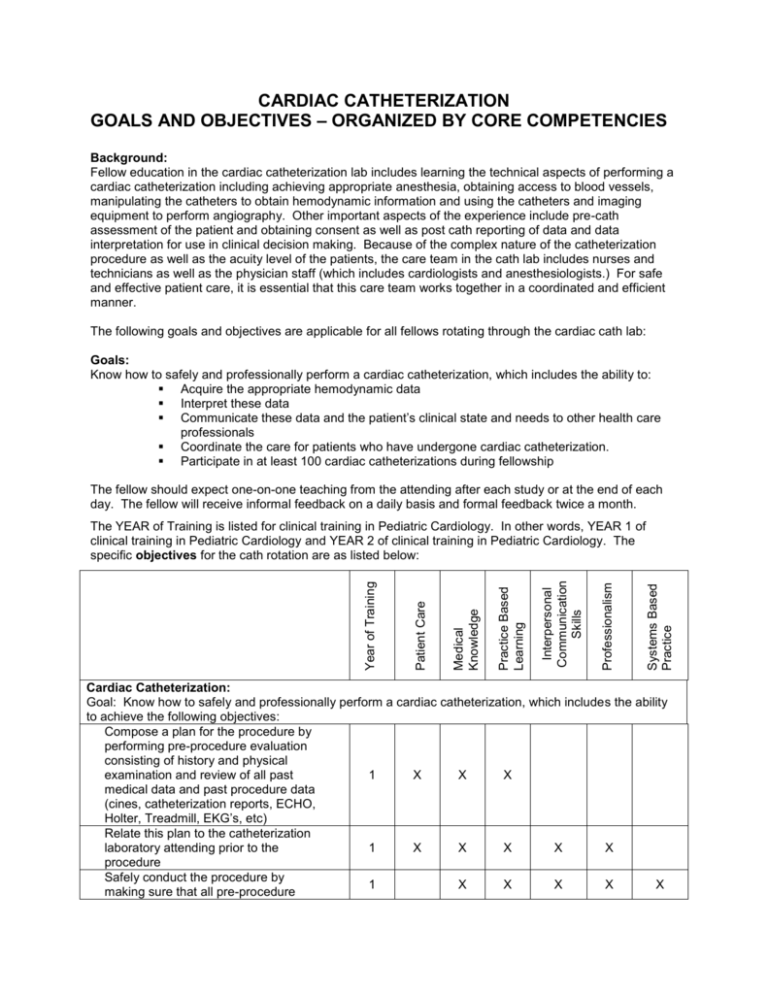
CARDIAC CATHETERIZATION GOALS AND OBJECTIVES – ORGANIZED BY CORE COMPETENCIES Background: Fellow education in the cardiac catheterization lab includes learning the technical aspects of performing a cardiac catheterization including achieving appropriate anesthesia, obtaining access to blood vessels, manipulating the catheters to obtain hemodynamic information and using the catheters and imaging equipment to perform angiography. Other important aspects of the experience include pre-cath assessment of the patient and obtaining consent as well as post cath reporting of data and data interpretation for use in clinical decision making. Because of the complex nature of the catheterization procedure as well as the acuity level of the patients, the care team in the cath lab includes nurses and technicians as well as the physician staff (which includes cardiologists and anesthesiologists.) For safe and effective patient care, it is essential that this care team works together in a coordinated and efficient manner. The following goals and objectives are applicable for all fellows rotating through the cardiac cath lab: Goals: Know how to safely and professionally perform a cardiac catheterization, which includes the ability to: Acquire the appropriate hemodynamic data Interpret these data Communicate these data and the patient’s clinical state and needs to other health care professionals Coordinate the care for patients who have undergone cardiac catheterization. Participate in at least 100 cardiac catheterizations during fellowship The fellow should expect one-on-one teaching from the attending after each study or at the end of each day. The fellow will receive informal feedback on a daily basis and formal feedback twice a month. Systems Based Practice Professionalism Interpersonal Communication Skills Practice Based Learning Medical Knowledge Patient Care Year of Training The YEAR of Training is listed for clinical training in Pediatric Cardiology. In other words, YEAR 1 of clinical training in Pediatric Cardiology and YEAR 2 of clinical training in Pediatric Cardiology. The specific objectives for the cath rotation are as listed below: Cardiac Catheterization: Goal: Know how to safely and professionally perform a cardiac catheterization, which includes the ability to achieve the following objectives: Compose a plan for the procedure by performing pre-procedure evaluation consisting of history and physical examination and review of all past 1 X X X medical data and past procedure data (cines, catheterization reports, ECHO, Holter, Treadmill, EKG’s, etc) Relate this plan to the catheterization laboratory attending prior to the 1 X X X X X procedure Safely conduct the procedure by 1 X X X X X making sure that all pre-procedure 1 Systems Based Practice Professionalism Interpersonal Communication Skills Practice Based Learning Medical Knowledge Patient Care Year of Training preparations are in place (e.g., blood set-up, general anesthesia notified, PICU/PCICU or recovery room notified, etc.) Recognize radiation safety concerns and cite a basic understanding of radiation physics and radiology Discuss catheterization techniques, devices, and instrumentation Communicate and provide appropriate post-procedure care; achieved in part by: o Writing preliminary procedure note o Writing post-procedure orders o Relating the results of the study and status of the patient to those to whom care will be transferred, which will include other fellows and the residents o Monitoring patient recovery o Writing follow-up notes in patient chart, and formulating discharge plans Recognize the basis of function of the catheterization laboratory equipment and apply this knowledge to the performance of the procedure Perform vessel cannulation and insertion and removal of catheters successfully. By the end of the first three rotations, the fellow will successfully perform cannulation in over 50% of the patients and by the end of all the rotations, successfully cannulate and insert catheters in over 75% of the patients Relate an understanding of normal and abnormal physiology and normal and abnormal anatomy Characterize the cardiovascular anatomy of each patient for whom the fellow participates in their catheterization Obtain and begin to synthesize angiographic and hemodynamic data Obtain and synthesize all angiographic and hemodynamic data Relate pathophysiologic states to the X X 2 X X X X X 1 X X X X X X X X X X X 1 2 X X X 1 X X X 1 X X X 1 X X X 2 X X X 1 X X X X X Professionalism Systems Based Practice Interpersonal Communication Skills X X X X X 1 X X X X X X Complete procedure reports within three days without being reminded 1 X X X X X X Be punctual, courteous and polite at all times 1 X X X X X X Utilize medical literature and apply to patient care 1 X X X X X X Utilize health system to optimize patient care 1 X X X X X X 1 X X X X X 1 X X X X X Coordinate care of patients Communicate effectively with parents and patients X Practice Based Learning Patient Care X Medical Knowledge Year of Training 1 angiographic and hemodynamic data Communicate important findings and management changes to other health care providers, including referring physician. Collaborate effectively with all coworkers
